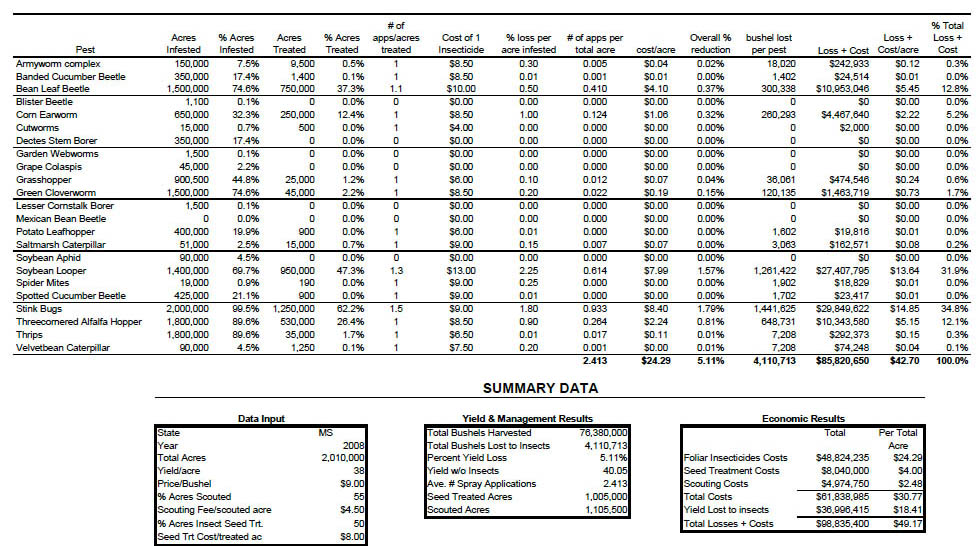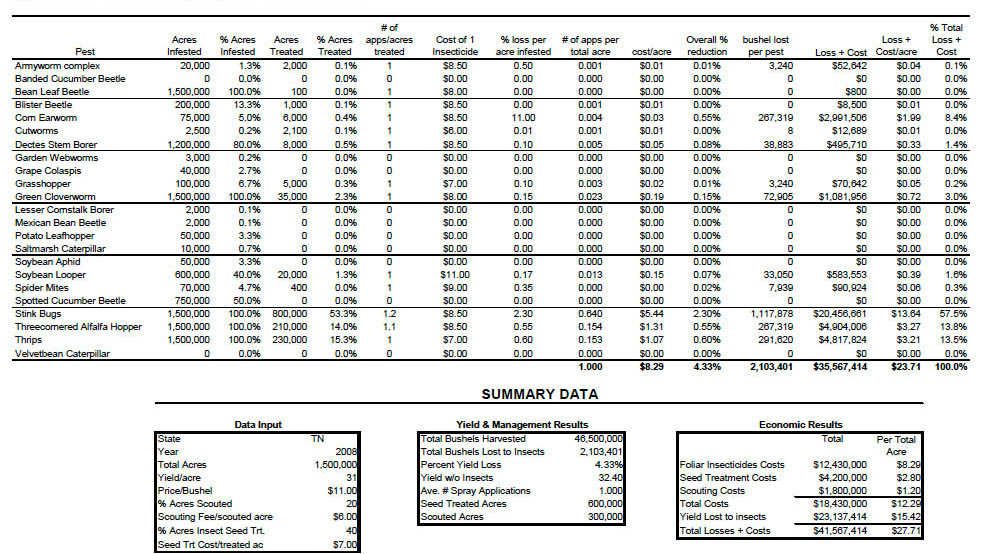Report
2008 Soybean Insect Losses for Mississippi and Tennessee [pdf]
Musser, F. R.*1, S. D. Stewart2 and A. L. Catchot, Jr1
1Department of Entomology and Plant Pathology, Mississippi State University, Box 9775, Mississippi State, MS 39762
2WTREC, The University of Tennessee, 605 Airways Blvd., Jackson TN 38301
*corresponding author email: fm61@msstate.edu
Accepted: 8-XII-2008
Abstract Survey-based soybean insect losses provide a glimpse of current soybean management practices and allow one to see evolving trends. Continuing a survey begun in 2004 in Mississippi, the 2008 survey showed that seed treatments were used extensively for the first time and soybean acreage monitored by crop scouts continued to increase. Stink bugs (Hemiptera: Pentatomidae) remained the most important pest in Mississippi followed by soybean looper (Lepidoptera: Noctuidae), bean leaf beetle (Coleoptera: Chrysomelidae) and threecornered alfalfa hopper (Hemiptera: Membracidae). In the first year of published losses for Tennessee, economic costs in yield loss plus control costs were greatest for stink bugs, threecornered alfalfa hoppers and thrips (Thysanoptera: Thripidae).
Key Words: soybean, yield loss, pest management
Introduction
Mississippi soybean losses have been compiled annually since 2004 (Musser and Catchot 2008), providing an annual record of insect pressure and management decisions. This year’s report also includes insect losses from Tennessee to provide a broader picture of soybean insect management in the Midsouth. These estimates are based on surveys of consultants and extension personnel, similar to those used to estimate insect losses in cotton (Williams 2006). While the costs and losses estimated for a pest in any given year are subjective, these losses provide an historical record of pest pressure and management practices and provide an estimate of the economic impact of the various soybean pests. We encourage entomologists in other states to begin estimating losses so that we may gain a better regional or national picture of the impact of insect pests on soybean production.
Materials and Methods
A survey was sent to crop consultants and extension personnel in the fall of the year. Surveyed people were those who actively scouted soybean fields and those who assisted growers in making soybean pest management decisions. These surveys were compiled and then combined with our own experience to estimate the various fields in the table. Acreage, yield and price data were drawn from Agricultural Statistics Service publications (USDA NASS 2007). The estimates were placed in an Excel spreadsheet (Microsoft Office 2003, Microsoft Corp.) to make the various calculations. The actual formulas used in the spreadsheet are in Musser and Catchot (2008).
Results and Discussion
Soybean insect pest management intensity continued to increase in 2008 as measured by scouted acreage, use of seed treatments, and the application of foliar insecticides (Table 1). Seed treatment usage was widespread for the first time in 2008. There was no evidence of seed treatments replacing any foliar insecticides as the number of foliar applications was higher than in any of the previous years surveyed. Total losses plus cost was higher than other years even while percent yield loss was lower than in previous years. This was a function of the high value of soybeans, increased use of seed treatments and more foliar insecticide applications.
Table 1. Mississippi average soybean management and performance, 2004-2008.

Table 2 compares the major pests in Mississippi and Tennessee in 2008. Stink bugs (Hemiptera: Pentatomidae), a complex of southern green (Nezara viridula), green (Acrosternum hilare), brown (Euschistus servus), red-shouldered (Thyanta spp.) and red-banded (Piezadorus guildinii) stink bugs were the major pests of soybeans in both states, infesting nearly every acre. Threecornered alfalfa hopper, Spissistilus festinus (Hemiptera: Membracidae), also caused substantial losses in both states. Soybean looper, Pseudoplusia includens (Lepidoptera: Noctuidae), and bean leaf beetle, Ceratoma trifurcata (Coleoptera: Chrysomelidae), were substantial pests in Mississippi, while thrips (Thysanoptera: Thripidae) were a more costly pest in Tennessee. Beyond the species listed in Table 2, yield losses and insecticide applications were relatively rare for all other pests in both states in 2008 (Appendices 1, 2).
Table 2. Losses and management of major soybean pests in Mississippi and Tennessee, 2008.

One factor that was not been broken out in these soybean losses is the impact of double-cropped soybeans following wheat. Double-cropped acreage accounted for approximately 27 and 41% of all soybean acres in Mississippi and Tennessee, respectively, in 2008. These acres tended to receive more foliar applications for soybean looper, corn earworm and stink bugs and had lower yields than early-season soybeans.
Acknowledgements
These losses could not be calculated without the assistance of numerous crop consultants and extension personnel who willingly completed this survey each year. We also acknowledge Michael Williams who has compiled insect losses in cotton for many years and gave us the idea to start a similar program in soybeans.
References
Musser, F. R., and A. Catchot. 2008. Mississippi soybean insect losses. Midsouth Entomol. 1: 29-36.
USDA NASS. 2007. NASS-Mississippi Reports and Statistics, http://www.nass.usda.gov/Statistics_by_State/Mississippi/index.asp.
Williams, M. R. 2006. Cotton insect losses, http://www.msstate.edu/Entomology/Cotton.html.
Appendix 1. Mississippi soybean insect losses, 2008.
Appendix 2. Tennessee soybean insect losses, 2008.


